- 24H Open Interest$128,664,841,695.184.94%
- 24h Liquidation$192,729,765.620%
- 24h long/short Ratio49.5% / 50.5%
- Fear & Greed Index27
- Bitcoin Price$89,400.41.67%
- Ethereum Price$3,048.852.21%
- Solana Price$128.382.79%
- XRP Price$1.92.5%
- 24H Open Interest$128,664,841,695.184.94%
- 24h Liquidation$192,729,765.620%
- 24h long/short Ratio49.5% / 50.5%
- Fear & Greed Index27
- Bitcoin Price$89,400.41.67%
- Ethereum Price$3,048.852.21%
- Solana Price$128.382.79%
- XRP Price$1.92.5%
Best Decentralized Perpetual Exchanges in 2025
Discover the top decentralized perpetual exchanges in 2025, ranked by speed, liquidity, leverage, and features across multiple blockchains.
Key Takeaways:
- Decentralized perpetual exchanges provide users with self-custody, transparent trading, and access to high leverage without relying on central control or intermediaries.
- Platforms like Hyperliquid, Jupiter, edgeX and Aster lead in 2025 by delivering exceptional speed, deep liquidity, and sophisticated order execution tools.
- Innovations such as gasless orders, sub-accounts, and hybrid liquidity models are making decentralized perps more competitive with traditional centralized exchanges.
Hyperliquid
Hyperliquid is the largest and most liquid decentralized perpetuals exchange, processing over $2 trillion in volume on a custom Layer-1 with sub-second finality.
Features
Fees
Regulation
Overall Rating
Centralized perpetual platforms have long kept traders on edge, plagued by hidden risks such as counterparty failures, opaque liquidation mechanisms, and central authorities holding ultimate control over user funds. These vulnerabilities were harshly exposed by high-profile collapses, like the FTX crash in 2022.
Decentralized perpetual exchanges offer an escape from these pitfalls by removing the reliance on intermediaries, giving traders direct custody of their assets. After years of on-chain trading, we’ve narrowed it down to this shortlist of the top decentralized perp platforms:
Best Decentralized Perpetual Exchanges in 2025
Our expert team has rigorously tested and evaluated numerous decentralized perpetual exchanges, analyzing metrics such as liquidity, security, usability, and fee structures. The following seven exchanges represent the top choices for traders seeking trustworthy decentralized perpetual trading in 2025.
1. Hyperliquid
Ranked #1 for a reason, Hyperliquid has processed over $2 trillion in cumulative trading volume across 100+ perpetual markets. The exchange operates on a custom Layer-1 blockchain, easily handling 200,000 orders per second with instant one-block finality.
Hyperliquid’s perpetual contracts offer linear margining in USDC and settle profits directly in USDT, eliminating the need for currency conversions and simplifying trading strategies. Fees are highly competitive, with active traders benefiting from 0% maker fees and rebates of up to -0.003%.
Risk management is transparent and consistent, providing up to 40x leverage with maintenance margin always fixed at 50% of initial margin. However, newer traders should be cautious with advanced order features like TWAP fills, which can be somewhat complex.
Pros
- Continuous throughput optimization exceeding 200k orders/sec.
- Spot volume counts double towards fee discounts.
- Fully transparent one-block finality trades.
Cons
- Permanent staking link risks trading account control.
- Limited slippage tolerance (3%) for TWAP suborders.
- Complex management of partially filled OCO orders.
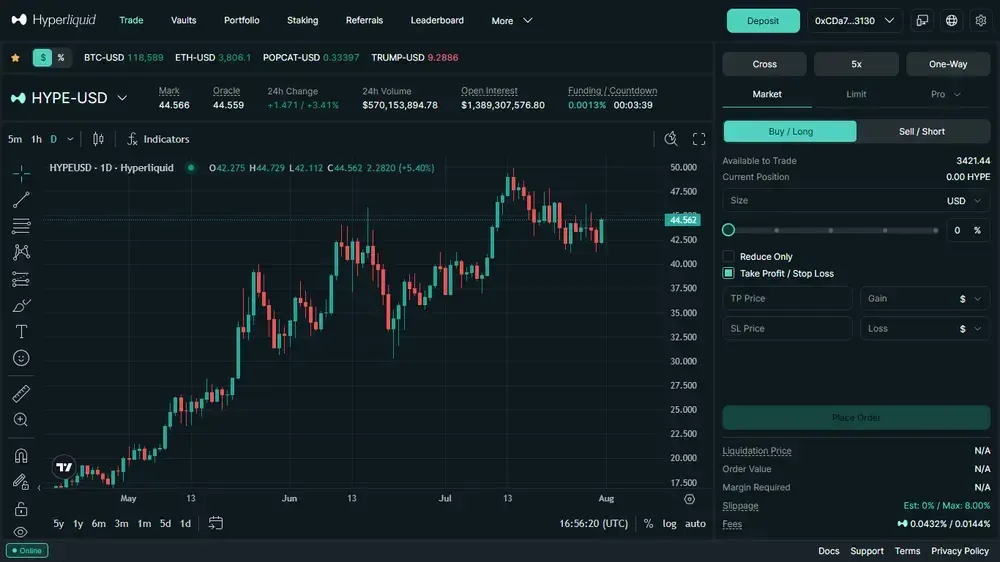
2. Jupiter
We find Jupiter impressive, particularly for offering the highest leverage on Solana, with up to 150x on ETH and wBTC. Its liquidity structure, provided through the JLP Pool, ensures traders consistently access ample liquidity without traditional order-book slippage.
Trading fees are transparent, featuring a straightforward 0.06% base fee combined with a unique price impact fee, effectively simulating traditional exchanges. We also appreciate Jupiter's innovative gasless orders feature, significantly streamlining trades by utilizing an off-chain keeper execution model.
However, we note caution regarding Jupiter's non-FIFO execution method, which could create uncertainty for limit orders placed near liquidation prices. Additionally, limit orders temporarily become unavailable when market utilization exceeds 80%, potentially disrupting traders' strategies during high-volatility periods.
Pros
- Borrow fees replace traditional hourly funding rates.
- Automatic APR accrual in LP tokens without staking.
- Supports collateral swapping via Jupiter Instant.
Cons
- No FIFO execution can complicate liquidation management.
- Liquidation priority can override active orders.
- Hourly compounding borrow fees increase position costs.
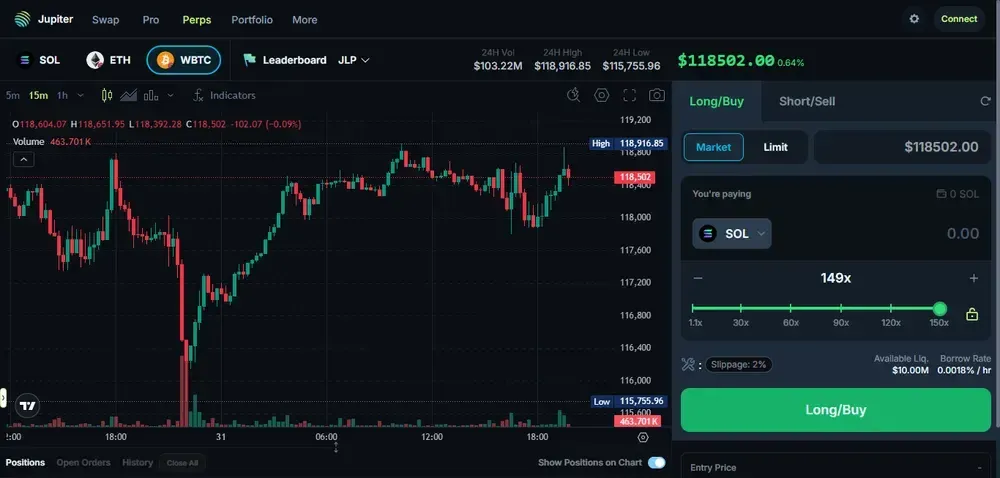
3. edgeX
It's impressive how edgeX has gradually risen to now dominate Ethereum perps, with $79 billion in cumulative volume from over 34,000 users, surpassing household names like dYdX. Backed by StarkWare’s ZK-proof tech and Amber Group’s liquidity, it combines security, performance, and institutional-grade depth.
Traders can access up to 100x leverage with USDT-margin linear contracts and manage risk through sub-accounts, hedge mode, and reduce-only order features. We particularly value the ability to create up to 20 isolated margin accounts per wallet, supporting advanced strategy segmentation.
The fee model combines tiered maker-taker rates with hourly funding, calculated using real-time TWAP-based premiums and interest rate spreads. Conditional and advanced order types (including Fill-or-Kill and Post-Only) give us the precision we expect from a high-volume venue.
Pros
- TP/SL configuration allowed post-execution only.
- Cross-chain deposits supported for wallet flexibility.
- Sub-accounts prevent portfolio-wide liquidation risk.
Cons
- Funding rate dampener capped at ±0.05%.
- TP/SL triggers only use last traded price.
- All TP/SL orders default to reduce-only mode.
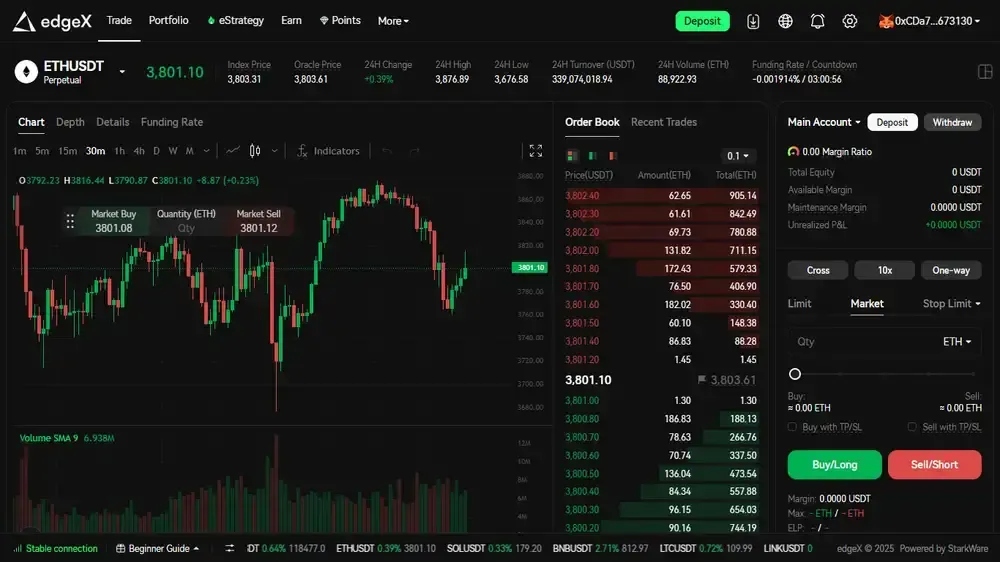
4. Aster
We have a confession to make: we've lost a couple dozen trades on Aster, and honestly, it's understandable. The now million-user-strong perps exchange on BNB Chain, Arbitrum, and Base supports a thrilling but unforgiving 1001x leverage (the highest on the list) that invites instant liquidations.
The dual-mode system, Simple (one-click trading) and Pro (order book), ensures broad accessibility while providing low fees (0.01% maker, 0.035% taker). We particularly appreciate its innovative "Degen Mode," offering zero opening fees and minimal slippage for ultra-high leverage BTC trades.
Aster also excels in transparency, clearly outlining fees, liquidation formulas, and dynamic funding rates that adjust based on market volatility. However, traders should carefully manage risks due to high leverage and a complex, dynamic fee structure linked to realized profits.
Pros
- Transparent on-chain trades with zero deposit requirements.
- Flexible multi-asset margin across several blockchains.
- Ultra-low slippage (0.01%) in high-leverage Degen mode.
Cons
- Complex liquidation pricing formulas may confuse beginners.
- Dynamic closing fees linked directly to PnL outcomes.
- Unable to add margin after positions open in Degen mode.
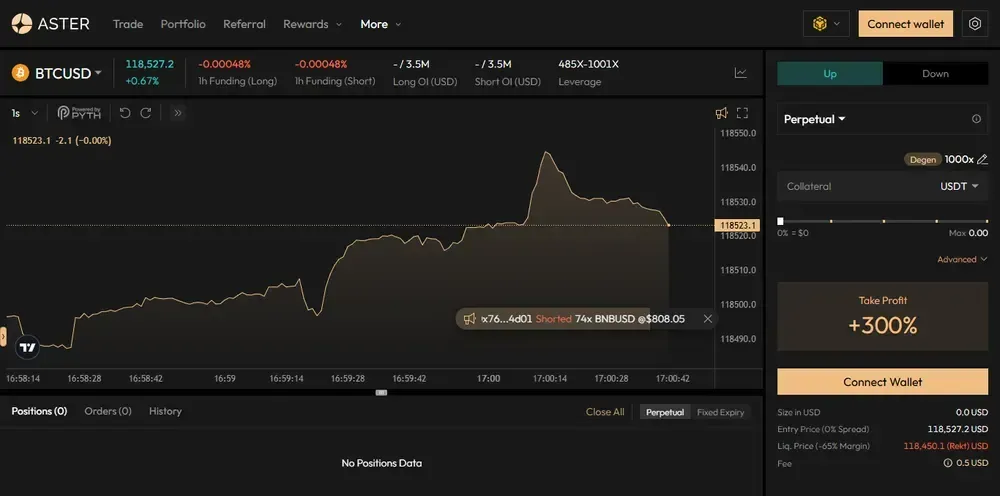
5. ApeX Protocol
ApeX's intent-centric approach can't go unnoticed: efficiently aggregating multichain liquidity without cumbersome bridging, now even including tokenized US stocks. Traders enjoy perpetual contracts with up to 100x leverage, zero gas fees, and onchain speeds reaching 10,000 transactions per second.
Its new offering extends beyond crypto, enabling 24/7 trading of fractional tokenized stocks like Apple and Tesla with USDT, with no KYC required. ApeX's Grid Bot further improves efficiency, rewarding automated trades with negative maker fees, incentivizing deeper market participation.
Advanced conditional orders, hourly funding rate settlements, and cross-margin accounts complement its solid derivatives suite, appealing to sophisticated traders. Live prediction markets and spot swaps round out its complete product suite, securing ApeX Omni as a full-featured decentralized trading protocol.
Pros
- Trade tokenized US stocks without KYC.
- Negative maker fees on automated grid bot trades.
- High liquidity across multiple chains without bridging.
Cons
- Traders lack legal shareholder rights for tokenized stocks.
- Fee discounts limited to initial beta period.
- Collateral restricted primarily to USDT.
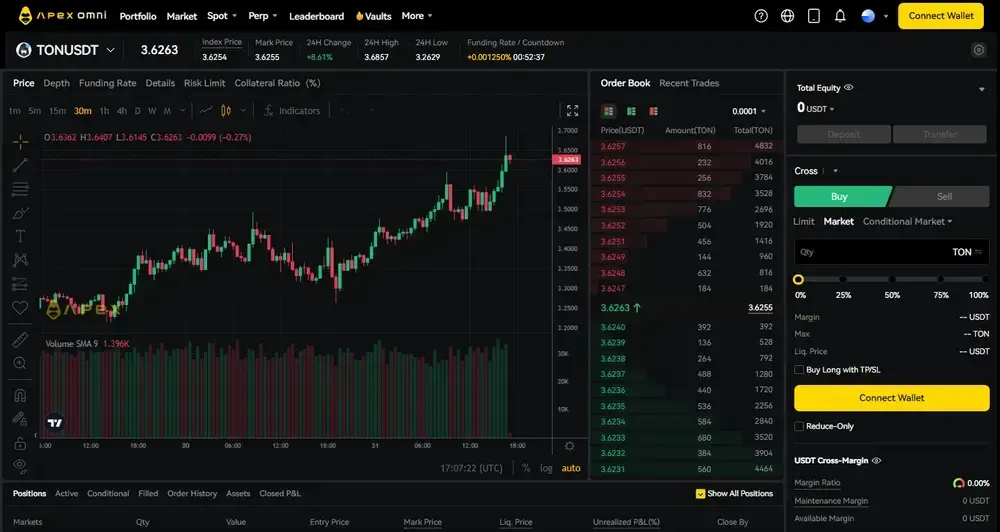
6. Drift
Drift earns its spot as Solana’s second-largest perpetual exchange through a unique blend of AMM, decentralized orderbook, and JIT liquidity. Traders can access specialized tools such as Oracle Limit and Protected Maker orders, enhancing execution control beyond standard market and limit orders.
Its High Leverage Mode stands out, offering increased leverage (101x) specifically on major pairs like SOL, BTC, and ETH, even with limited access. We found Drift’s capital-efficient prediction markets compelling, allowing collateralization with over 30 tokens and enabling yield generation while holding positions.
Fees are competitive, starting at just 3 bps for VIP takers, complemented by maker rebates, though premium charges apply to select assets. The hybrid liquidity model effectively minimizes slippage and spread issues common in other decentralized exchanges, relying on incentivized Keeper Bots.
Pros
- Oracle-driven orders increase execution precision.
- Capital-efficient predictions with diverse token collateralization.
- Hybrid liquidity significantly reduces trade slippage.
Cons
- Restricted availability for High Leverage Mode.
- Elevated fees on certain spot markets.
- Keeper Bot dependency may affect liquidity reliability.
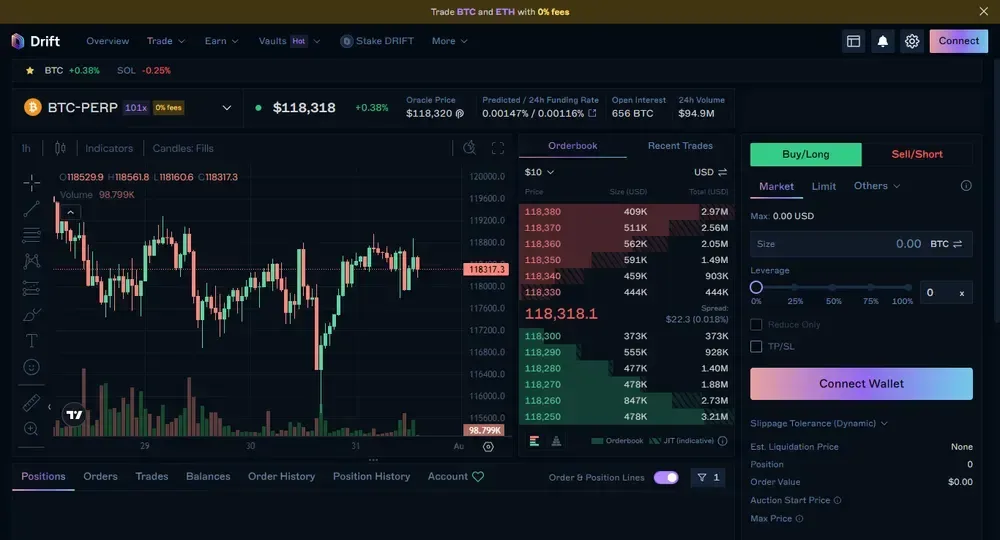
7. dYdX
As DeFi's longest-running perpetuals platform, dYdX continues to generate $7-8 billion monthly volume despite heavy competition from newer exchanges. Its novel Cosmos-based "v4" chain decentralizes the entire order flow, ensuring trades settle swiftly through a validator consensus system.
We appreciate dYdX’s sophisticated order management, including short-term, stateful, and conditional orders, offering precise execution tailored to varied strategies. Leveraged perpetual contracts (up to 50x) with USDC collateral remain user-friendly, minimizing exposure to volatile crypto assets.
However, while its comprehensive front-end interfaces (web, iOS, Android) are highly functional, the overall user experience feels less intuitive compared to newer rivals. Still, its combination of proven reliability, deep liquidity, and transparent, decentralized architecture makes dYdX relevant even among flashier competitors.
Pros
- Great fee schedule starting from 0.05% taker and 0.01% maker.
- Versatile short-term and long-term order options.
- Collateral management simplified with USDC focus.
Cons
- Less intuitive interfaces than competitors.
- Limited asset support beyond primary collateral tokens.
- Higher complexity for casual or beginner traders.
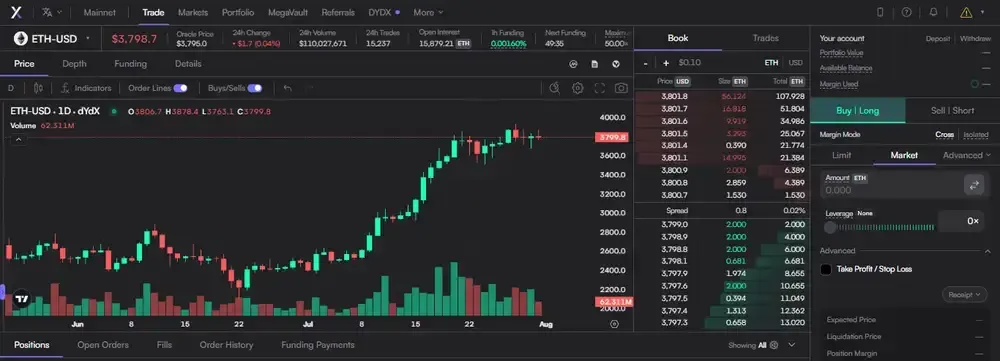
What Exactly Is a Decentralized Perpetual Exchange?
A decentralized perpetual exchange is a DeFi trading platform that allows traders to speculate on asset prices without relying on centralized intermediaries. Unlike traditional futures contracts, perpetual contracts on these exchanges have no expiration date, enabling continuous leveraged trading.
Decentralized perpetual exchanges primarily fall into two categories: automated market maker (AMM) models and decentralized order book models. AMM-based platforms like GMX provide deep liquidity through pooled assets, while order book exchanges like dYdX directly match buyers with sellers.
According to DefiLlama, the onchain perpetual market reached an all-time monthly trading volume of $462.74 billion in July 2025, with Hyperliquid capturing roughly 65% of that total, or around $300 billion. Additionally, Hyperliquid's open interest (IO) alone sits at $4 billion, or about 5% of the entire Bitcoin OI.
In our expert opinion at Coinperps, two critical elements are needed to maintain genuine decentralization in DeFi perpetual exchanges: at least three additional platforms matching Hyperliquid’s capabilities, and a substantial increase (ideally 2-4x) in overall liquidity distributed across these exchanges.
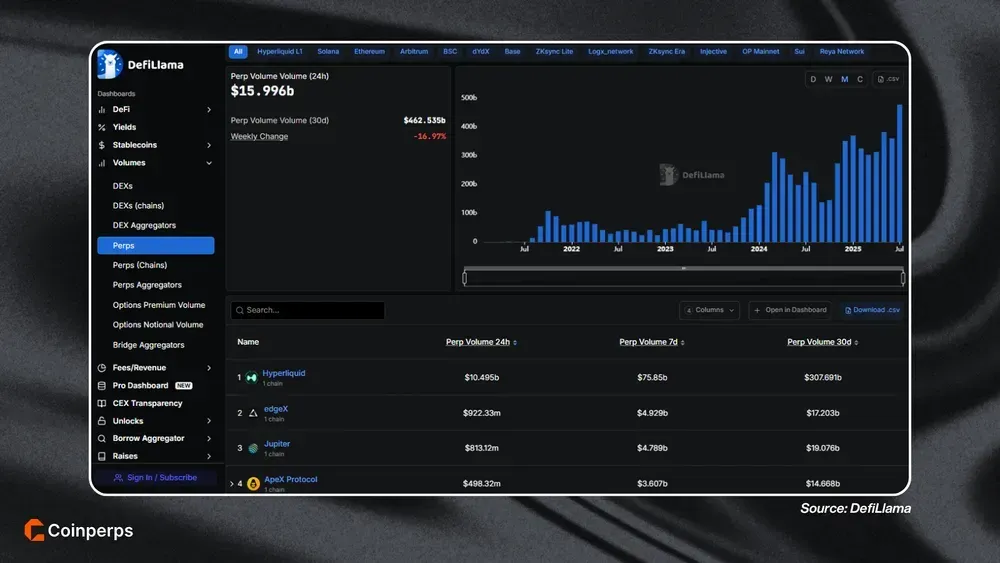
How Trading Fees Work on Decentralized Perps
Trading fees on decentralized perpetual exchanges represent the costs traders pay when opening, closing, or maintaining positions. These fees incentivize liquidity providers, balance markets, and ensure that the platform functions smoothly without intermediaries.
Maker Fees
Maker fees apply when traders place limit orders that add liquidity to the exchange's order book, typically resulting in lower costs or even fee rebates. Exchanges encourage limit (maker) orders to enhance market depth, thus rewarding traders who help stabilize price fluctuations.
Example: At a $200,000 trading volume, Aster has the lowest maker fee cost at $70, while Jupiter is the most expensive at $120. Drift, despite high leverage, charges just $50, making it the cheapest at that volume.
Tip: Place limit orders slightly away from current market prices to ensure your orders qualify as maker orders.
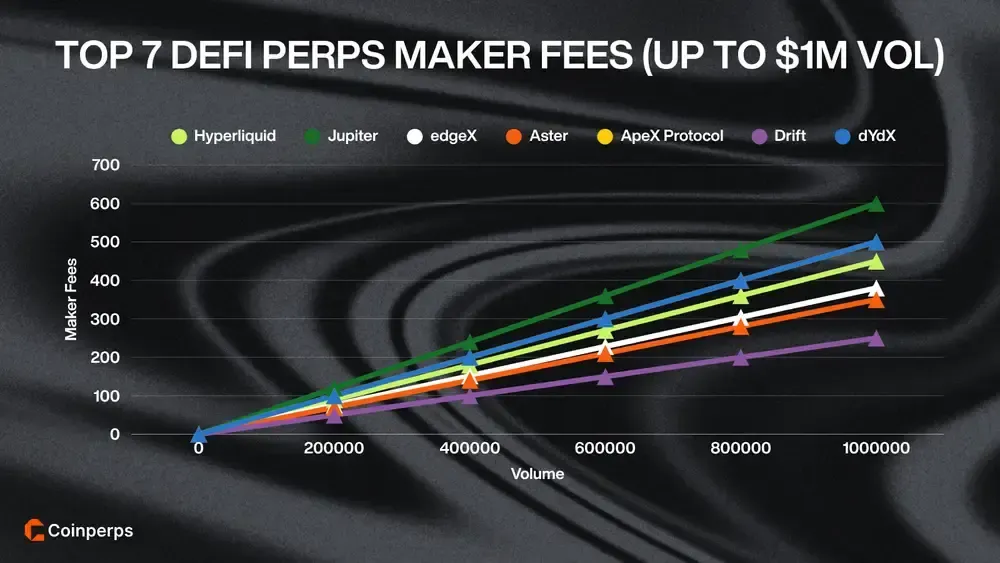
Taker Fees
Taker fees occur when traders execute market orders or immediate-limit orders that remove liquidity from the exchange’s order book, generally resulting in higher trading costs. These orders remove liquidity and thus incur these fees to compensate for the risk and resources required to maintain available liquidity.
Example: Aster charges a taker fee of 0.01%, so a market order of $200,000 would cost just $20 in fees. Drift currently offers 0% taker fees on BTC and ETH markets due to a 100% discount, while SOL markets have a 75% discount applied to the base rate.
Tip: Limit market orders during peak volatility to avoid excessive fees and slippage, or consider using maker orders instead.

Funding Rates
Funding rates are periodic fees exchanged between traders holding long and short positions to align perpetual contract prices with underlying spot market prices. Positive funding rates indicate long-position holders pay short-position holders, while negative funding rates mean short-position holders pay longs.
Example: On edgeX, funding rates are calculated hourly using real-time TWAP-based premiums, capped at ±0.05%; thus, a $10,000 long position with a 0.05% funding rate costs $5 per funding period.
Tip: Monitor and strategically enter or exit positions to capitalize on favorable funding rates or to minimize exposure to frequent charges.

Liquidation Fees
Liquidation fees are penalties applied when a trader's margin falls below a minimum threshold, forcing the exchange to automatically close their position. These fees cover liquidation costs and incentivize users to manage their risk responsibly.
Example: On Drift, if you open a $5,000 SOL-PERP position with $500 collateral at 10x leverage, a 5.28% price drop could trigger liquidation. Your remaining collateral would be reduced by your unrealized loss, effectively ending the position with minimal residual margin.
Tip: Always set conservative leverage and maintain sufficient margin to avoid liquidation fees.

Network Fees
Network fees cover the blockchain transaction costs involved in submitting and executing trades or other transactions on decentralized exchanges. These fees vary based on blockchain congestion, transaction complexity, and network used.
Example: On Arbitrum-based platforms like GMX, a trade might incur around $0.10-$0.20 per transaction during average network conditions.
Tip: Hyperliquid offers zero network fees with one-click executions, removing both transaction costs and wallet confirmations.
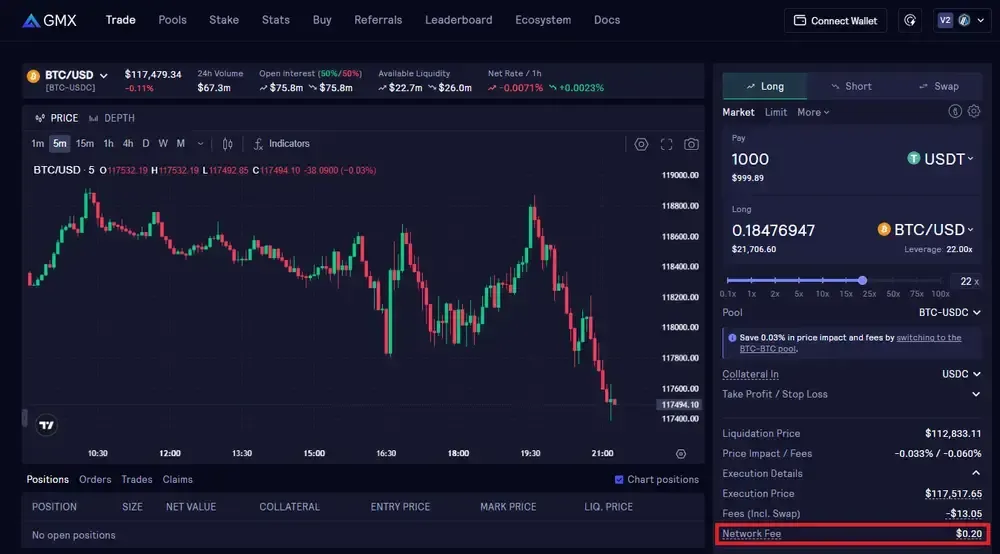
Risks When Using DeFi Perpetual Exchanges
Users of DeFi perpetual exchanges face risks including smart contract vulnerabilities, liquidation risks, liquidity problems, and price manipulation threats.
Below, we detail each risk to help traders protect their assets:
- Smart Contract Vulnerabilities: Exploits like GMX’s $42 million exploit due to re-entrancy vulnerabilities highlight persistent threats from smart contract coding flaws.
- Liquidation Risk: Leveraged perpetual positions are sensitive to abrupt market swings, potentially causing automatic liquidations at highly unfavorable rates, amplifying losses.
- Liquidity Risk: AMM-style liquidity pools backing perpetuals can encounter severe slippage or token imbalances, especially during large trades or sudden liquidity withdrawals.
- Price Manipulation: Oracle manipulations via flash loans or TWAP abuse often lead to inaccurate liquidations or collateral valuations, frequently exploited in perpetual markets.
- MEV and Market Manipulation: Front-running and sandwich attacks accounted for over 10,000 unfair trades on Ethereum a day, causing users losses exceeding $14 billion a month (per EigenPhi).
- Governance Centralization: Privileged admin keys or centralized developer control over upgrades expose exchanges to potential governance attacks and unexpected critical parameter changes.
- Cross-chain Bridge Risk: Perpetual platforms operating across multiple chains, such as Aster on Arbitrum and BNB Chain, face heightened vulnerability through bridging logic complexities.
- Recovery and Insurance Limitations: Post-hack recovery on decentralized platforms is rare, with no guaranteed insurance; even partial returns, like GMX’s recovery, burden liquidity providers.
Bottom Line
The future of decentralized perpetual exchanges points towards lightning-fast transactions, near-zero fees, and new leverage innovations that would make even seasoned traders blush.
Users who stay alert to these advancements, like gasless trades and tokenized stocks without KYC, will ride the wave rather than be swept under it.
So keep your eyes peeled… because in crypto, the early bird doesn't just catch the worm, it bags the whole market, especially when leverage is in play.
Frequently asked questions
Most decentralized perpetual exchanges support Web3 wallets like MetaMask, Phantom, Rabby, and WalletConnect-compatible options. Some platforms also support hardware wallets (e.g., Ledger) and mobile-native wallets, depending on the blockchain they're built on.
Yes, the majority of decentralized perpetual exchanges do not require KYC, allowing users to trade anonymously using only a connected crypto wallet, though IP tracking may still apply.
Some exchanges, like dYdX, offer dedicated iOS and Android apps, while others rely on mobile browser wallet integration. The mobile UX can vary widely depending on the platform.
Decentralized exchanges often use TWAP or oracle-based data to calculate funding, while centralized platforms may use internal order book data, leading to potentially different funding timing and volatility.
Yes, some platforms support bot integrations via API or smart contract interaction. Advanced users can also build custom bots using tools like Chainlink Functions, Gelato, or external keepers.
.avif)